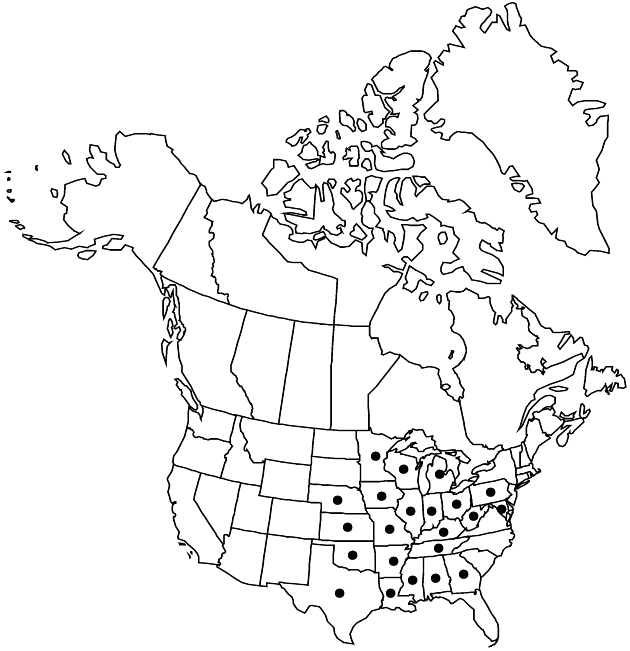Symphyotrichum drummondii
Phytologia 77: 279. 1995.
Perennials, 30–120 cm, cespitose; short-rhizomatous or with stout, often woody caudices. Stems 1–5+, erect (straight, stout), glabrate or glabrescent, sparsely pilose, or hirsuto-pilose proximally, ± densely so distally. Leaves (abaxially pale or grayish green, adaxially dark green) initially ± firm or membranous, becoming thicker, margins crenate-serrate to serrate, strigoso-ciliate to scabrous, apices acuminate to acute, mucronate, abaxial faces scabrous to densely piloso-strigose, more so on veins, adaxial scabrous to glabrate; basal withering by flowering, long-petiolate (petioles narrowly winged, sheathing, sometimes ciliate), blades ovate to ovate-oblong or -lanceolate to elliptic or suborbiculate, 10–85(–100) × 8–60 mm, bases deeply cordate to rounded or abruptly attenuate, margins crenate-serrate, apices usually rounded to obtuse, rarely acute; proximal cauline often withering by flowering, long-petiolate (petioles narrowly winged, more broadly so distally, ciliate), blades ovate or ovate-lanceolate, (25–)50–120(–150) × (15–)20–50(–65) mm, progressively to slightly reduced distally, bases deeply to shallowly cordate or rounded, margins crenate-serrate to sharply serrate; distal petiolate or subpetiolate or sessile, petioles broadly winged, blades ovate to ovate- or oblong-lanceolate, to oblong-elliptic or linear-lanceolate (4–)5–110 × 1–50 mm, reduced distally (sharply so on array branches in var. texanum), bases shallowly cordate or rounded to attenuate or cuneate (distally), margins crenate-serrate or -serrulate or entire. Heads in open, paniculiform arrays, branches ascending to divaricate, often densely racemiform or ± paniculiform (lateral ones open, racemiform) to subsecund, ± stiff to lax, long to relatively short, ± closely to ± remotely leafy, branch leaves progressively or ± abruptly reduced distally. Peduncles 0, or 0.2–1.5(–4) cm, densely ascending- or appressed-bracteate, pilosulous, bracts 4–17+, lanceolate or subulate to linear-oblanceolate, distally grading into phyllaries, pilosulous or strigoso-ciliate. Involucres campanulate, (3.5–)4.5–6(–6.5) mm. Phyllaries in 4–5 series, subulate or lanceolate (outermost) to narrowly oblong-lanceolate, unequal, bases indurate 1/4–3/4, margins narrowly scarious proximally, hyaline, ciliate, bodies sometimes green to margins distally, green zones lanceolate to linear-lanceolate, apices acute to acuminate or long-acuminate, tips often purple, sometimes involute, mucronulate, faces glabrous. Ray florets (8–)10–15(—20); corollas usually bright blue to purple or lavender, sometimes white, laminae (5–)7–10(–12) × 1–1.8 mm. Disc florets (10–)13–15(–22); corollas cream to yellow, becoming deep purple or reddish purple, 3.5–4.5(–5) mm, tubes shorter than funnelform to cylindric throats, lobes triangular to lanceolate, 0.4–0.7 mm. Cypselae dull purple or brown to tan (ribs tan to stramineous), obovoid, ± compressed, (1.5–)2–3 mm, 5–6-nerved, faces glabrate to sparsely strigillose distally; pappi cream to rose-tinged, 3–4 mm.
Distribution

Ala., Ark., Ga., Ill., Ind., Iowa, Kans., Ky., La., Md., Mich., Minn., Miss., Mo., Nebr., Ohio, Okla., Pa., Tenn., Tex., W.Va., Wis., ne Mexico.
Discussion
Varieties 2 (2 in the flora).
Variety texanum is tetraploid; var. drummondii is both diploid and tetraploid. The tetraploid race of var. drummondii is most likely autopolyploid; origin of var. texanum has not been determined. The two taxa intergrade and do not appear to warrant species status.
Selected References
None.
Key
| 1 | Plants 40–120 cm; stems proximally sparsely hirsute, distally densely so; leaves firm, basal and proximal long-petiolate, petioles ± winged, proximal bases ± cordate or truncate, sometimes obliquely; heads in ample, paniculiform arrays with divaricate or ascending, bracteate, often racemiform branches; peduncles ± secund, 0–4 cm, bracteate; involucres campanulate, (3.5–)4.5–7 mm; ray corollas usually bright blue, light purple, bluish violet, or lavender, sometimes white; cypselae glabrous | Symphyotrichum drummondii var. drummondii |
| 1 | Plants 30–80 cm; stems ± densely hirsute, particularly distally; leaves membranous, becoming thickish, brittle, basal and proximal winged-petiolate, proximal bases cordate, becoming rounded-truncate distally; heads in open, paniculiform arrays with very long, widely spreading branches; peduncles 1–4 cm, densely, minutely bracteate; involucres turbinate to hemispheric, 3.8–5.2 mm; ray corollas bluish white; cypselae strigillose | Symphyotrichum drummondii var. texanum |